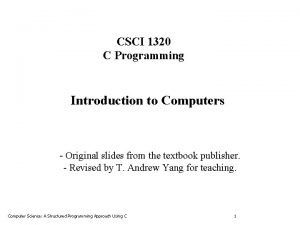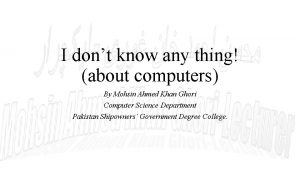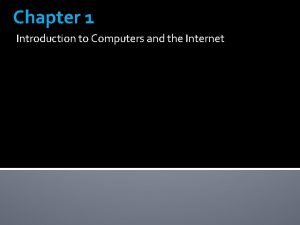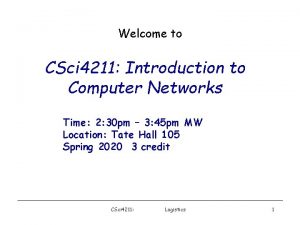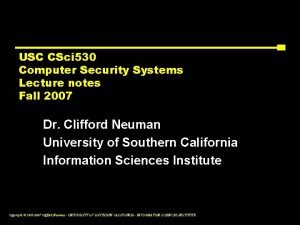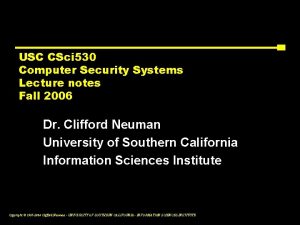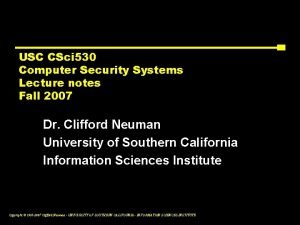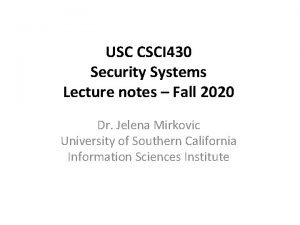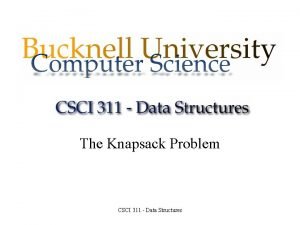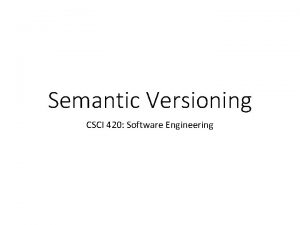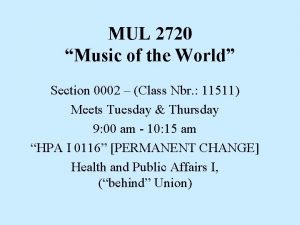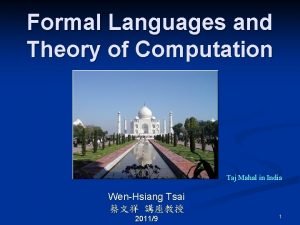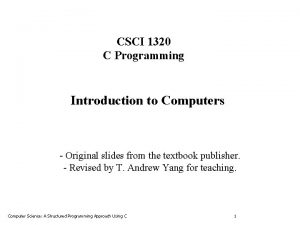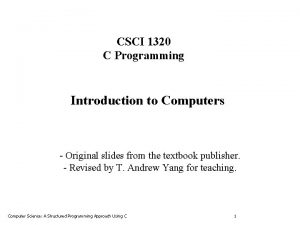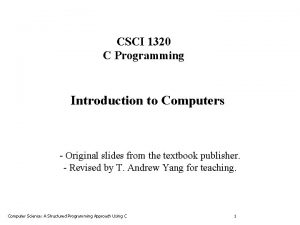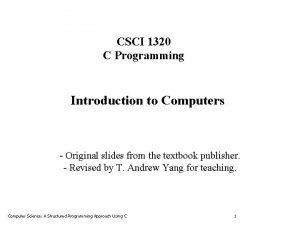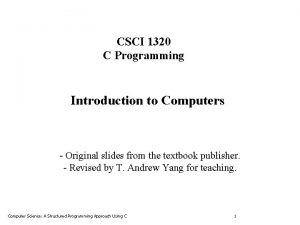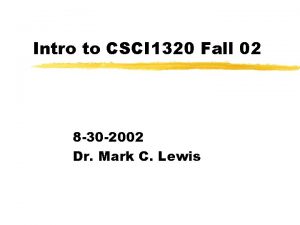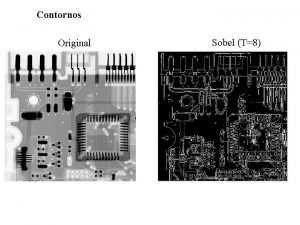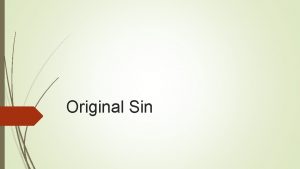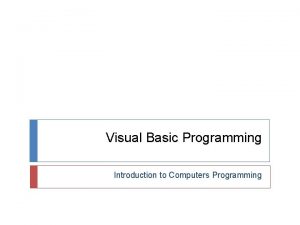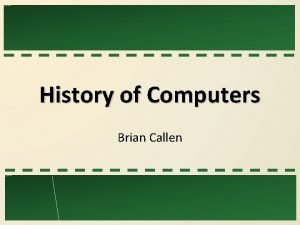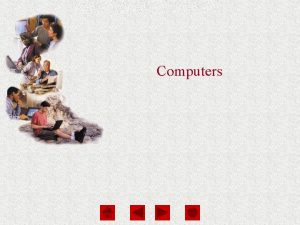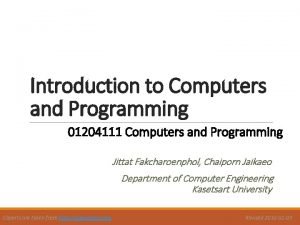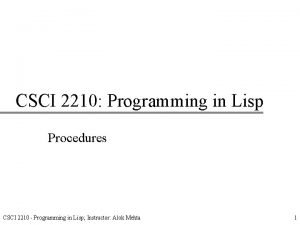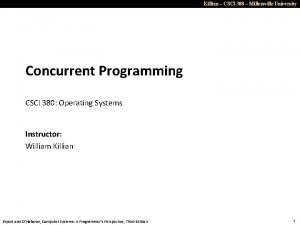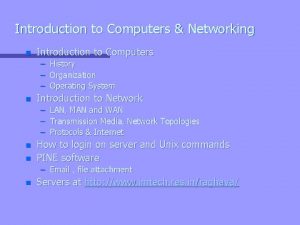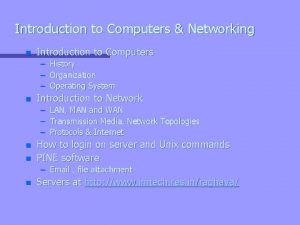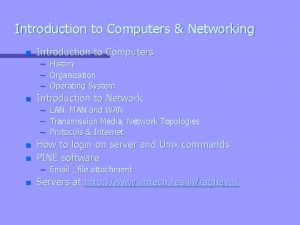CSCI 1320 C Programming Introduction to Computers Original





















- Slides: 21

CSCI 1320 C Programming Introduction to Computers - Original slides from the textbook publisher. - Revised by T. Andrew Yang for teaching. Computer Science: A Structured Programming Approach Using C 1

FIGURE 1 -1 A Computer System Computer Science: A Structured Programming Approach Using C 2

FIGURE 1 -2 Basic Hardware Components Computer Science: A Structured Programming Approach Using C 3

FIGURE 1 -3 Types of Software Computer Science: A Structured Programming Approach Using C 4

FIGURE 1 -4 Relationship between system and application software Computer Science: A Structured Programming Approach Using C 5

FIGURE 1 -6 Time-sharing Environment Computer Science: A Structured Programming Approach Using C 6

FIGURE 1 -7 The Client/Server Environment Computer Science: A Structured Programming Approach Using C 7

FIGURE 1 -8 Distributed Computing Computer Science: A Structured Programming Approach Using C 8

1 -3 Computer Languages To write a program for a computer, we must use a computer language. Over the years computer languages have evolved from machine language to natural languages. Topics discussed in this section: Machine Languages Symbolic Languages High-Level Languages Computer Science: A Structured Programming Approach Using C 9

FIGURE 1 -9 Computer Language Evolution Computer Science: A Structured Programming Approach Using C 10

PROGRAM 1 -1 The Multiplication Program in Machine Language Computer Science: A Structured Programming Approach Using C 11

Note The only language understood by computer hardware is machine language. Computer Science: A Structured Programming Approach Using C 12

PROGRAM 1 -2 The Multiplication Program in Symbolic Language Computer Science: A Structured Programming Approach Using C 13

PROGRAM 1 -3 The Multiplication Program in C continued Computer Science: A Structured Programming Approach Using C 14

PROGRAM 1 -3 The Multiplication Program in C (continued) Computer Science: A Structured Programming Approach Using C 15

1 -4 Creating and Running Programs In this section, we explain the procedure for turning a program written in C into machine language. The process is presented in a straightforward, linear fashion, but you should recognize that these steps are repeated many times during development to correct errors and make improvements to the code. Topics discussed in this section: Writing and Editing Programs Compiling Programs Linking Programs Executing Programs Computer Science: A Structured Programming Approach Using C 16

FIGURE 1 -10 Building a C Program Computer Science: A Structured Programming Approach Using C 17

Using the Tiny CC tool to develop a C program Note: tcc is available for free download from http: //download. savannah. gnu. org/releases/tinycc/. Computer Science: A Structured Programming Approach Using C 18

1 -5 System Development We’ve now seen the steps that are necessary to build a program. In this section, we discuss how we go about developing a program. This critical process determines the overall quality and success of our program. If we carefully design each program using good structured development techniques, our programs will be efficient, error-free, and easy to maintain. Topics discussed in this section: System Development Life Cycle Program Development Computer Science: A Structured Programming Approach Using C 19

FIGURE 1 -11 Waterfall Model Computer Science: A Structured Programming Approach Using C 20

Note Except for the most simple program, one set of test data will not completely validate a program. Computer Science: A Structured Programming Approach Using C 21
 Csci 1320
Csci 1320 1240-1320
1240-1320 Computer programming chapter 1
Computer programming chapter 1 Computer programming chapter 1
Computer programming chapter 1 Chapter 1 introduction to computers and programming
Chapter 1 introduction to computers and programming C programming chapter 1
C programming chapter 1 Introduction to computers
Introduction to computers Mainframe computer definition and examples
Mainframe computer definition and examples Perbedaan linear programming dan integer programming
Perbedaan linear programming dan integer programming Greedy programming vs dynamic programming
Greedy programming vs dynamic programming What is system programming
What is system programming Integer programming vs linear programming
Integer programming vs linear programming Programing adalah
Programing adalah Csci 4211
Csci 4211 Csci 530
Csci 530 Csci 530
Csci 530 Csci 530
Csci 530 Csci 430 usc
Csci 430 usc Csci 311
Csci 311 Major minor patch build
Major minor patch build Csci 2720
Csci 2720 Csci 1951a
Csci 1951a
